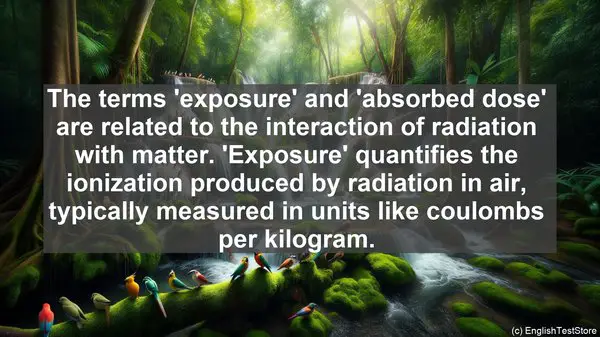Introduction
Welcome to today’s lesson on radiobiology. In this lesson, we’ll be discussing the top 10 commonly confused words in this field. Understanding these terms is crucial for accurate communication and interpretation of research findings. So, let’s get started!

1. Radiation vs. Radioactivity
The first pair of words that often cause confusion is ‘radiation’ and ‘radioactivity.’ While both are related to the emission of energy, they have distinct meanings. Radiation refers to the energy emitted, such as electromagnetic waves or particles. On the other hand, radioactivity is the property of certain elements to spontaneously emit radiation. So, radiation is the ‘what,’ and radioactivity is the ‘why.’

2. Dose vs. Dosage
Next, we have ‘dose’ and ‘dosage.’ These terms are frequently interchanged, but they have different implications. ‘Dose’ refers to the amount of radiation received, usually measured in units like gray or sievert. On the contrary, ‘dosage’ is the administration or prescription of a specific dose. So, while ‘dose’ is the quantity, ‘dosage’ is the act of giving that quantity.
3. Irradiation vs. Contamination
Moving on, ‘irradiation’ and ‘contamination’ are often used interchangeably, but they describe distinct situations. ‘Irradiation’ refers to the exposure to radiation, either intentionally or accidentally. On the other hand, ‘contamination’ is the presence of radioactive substances on surfaces or objects. So, one can be irradiated without being contaminated, and vice versa.
4. Exposure vs. Absorbed Dose
The terms ‘exposure’ and ‘absorbed dose’ are related to the interaction of radiation with matter. ‘Exposure’ quantifies the ionization produced by radiation in air, typically measured in units like coulombs per kilogram. On the other hand, ‘absorbed dose’ measures the energy deposited per unit mass in a material, often expressed in gray. So, exposure is about the ionization in air, while absorbed dose is about the energy deposition in matter.
5. Half-Life vs. Decay Constant
When discussing the decay of radioactive substances, ‘half-life’ and ‘decay constant’ are two crucial terms. ‘Half-life’ is the time it takes for half of the radioactive atoms in a sample to decay. It’s a characteristic property of each substance. On the other hand, ‘decay constant’ is a measure of the probability of decay per unit time. It’s related to the half-life but has different units. So, half-life is about the time, while decay constant is about the probability of decay.
6. Stochastic vs. Deterministic Effects
In radiobiology, we often encounter two types of radiation effects: ‘stochastic’ and ‘deterministic.’ ‘Stochastic effects’ are those that occur randomly, without a threshold. They’re usually associated with long-term exposure to low doses. On the contrary, ‘deterministic effects’ have a threshold and severity increases with dose. They’re typically observed after high-dose exposures. So, stochastic effects are random and low-dose, while deterministic effects have a threshold and are high-dose.
7. Biological Half-Life vs. Physical Half-Life
When discussing the elimination of radioactive substances from the body, we use ‘biological half-life’ and ‘physical half-life.’ ‘Biological half-life’ refers to the time it takes for the body to eliminate half of the administered substance. It’s influenced by factors like metabolism and excretion. On the other hand, ‘physical half-life’ is the time it takes for half of the radioactive atoms in a sample to decay. It’s a characteristic property of the substance. So, biological half-life is about the body’s elimination, while physical half-life is about the substance’s decay.
8. External Exposure vs. Internal Exposure
Radiation exposure can be classified as ‘external’ or ‘internal.’ ‘External exposure’ occurs when radiation sources are outside the body, and the energy penetrates to reach the tissues. On the other hand, ‘internal exposure’ happens when radioactive substances are taken into the body, either through ingestion or inhalation. So, external exposure is from outside, while internal exposure is from within.
9. Acute Exposure vs. Chronic Exposure
The duration of radiation exposure is an important factor. ‘Acute exposure’ refers to a high dose received over a short period, often resulting from accidents or therapeutic procedures. On the contrary, ‘chronic exposure’ is the long-term, low-dose exposure that occurs in occupational settings or natural background radiation. So, acute exposure is intense but short, while chronic exposure is prolonged but at lower levels.
10. ALARA Principle
Lastly, let’s discuss the ALARA principle. ALARA stands for ‘As Low As Reasonably Achievable.’ It’s a fundamental concept in radiation protection, emphasizing the need to minimize radiation exposure to the lowest practical level. This principle ensures that radiation risks are kept at bay while allowing necessary procedures. So, ALARA is about striking the balance between safety and essential activities.
